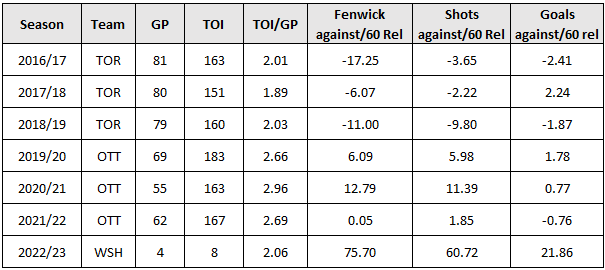I find whenever Ken Holland signs or acquires an experienced player, and mentions his penalty killing abilities, it’s definitely worth investigating further. There’s been more than a few instances where the Oilers general manager and professional scouts have misread a players abilities, still sign them, only to see them struggle and eventually depart the club. The two examples that instantly come to mind are Kyle Turris and Markus Granlund. Both were expected to help with the team’s depth and be effective penalty killers when their previous results clearly indicated otherwise.
- Kyle Turris as an option on the Oilers penalty kill – The SuperFan (2020, December 30)
- Background check – The SuperFan (2019, July 5)
Connor Brown is the latest player the Oilers have signed who has had experience on the penalty kill, which will be needed considering their shorthanded performance and results under Woodcroft haven’t been great. Last season, the Oilers penalty kill allowed the 12th highest rate of goals against in the league (8.52), largely driven by their inability to suppress offence as reflected by their rate of shots against per hour (58.31) – which was ninth highest in the league. Holland mentioned in his most recent press conference that the penalty kill is something they’d like to improve, and that Connor Brown, among others, are expected to help with the team’s overall defensive play.
He’ll be ready to go for Training Camp and ready to go for the season. I just think he’s a good hockey player. He’s got hockey sense, he can play 200 feet, he can kill penalties, and he’s got a couple of 20-goal seasons. So, I know he’s excited and I think he’s going to be a great fit for our team.
Edmonton Oilers
Below is a summary of Brown’s penalty-kill experience and on-ice performance numbers relative to his team from the last seven seasons. I removed his first season in Toronto where he only played seven NHL games, spending most of the 2015/16 season with the Marlies in the AHL as a 21 year old.
In his first three NHL seasons with Toronto (ages 22-24), Brown was mostly on the second penalty kill unit playing the third most shorthanded minutes among the Leafs forwards, and the fourth highest rate of minutes per game. The Leafs penalty kill had pretty good results in that three year period, allowing the ninth lowest rate of goals against, largely driven by their goaltending which posted a save percentage of 87.77%, sixth best in the league. The skaters really didn’t do that great of a job preventing unblocked shots attempts (i.e., Fenwick, a proxy for scoring chances) and shots against, as the team ranked at or below league average in this time period.
But with Brown on the ice, the Leafs did see a slight drop in the chances against, as reflected by his relative-to-team numbers in the table above. For example, with Brown on the ice between 2016-2019, the Leafs allowed a rate of 50.56 shots against per hour on the penalty kill. Without him, that rate increased by about 11% to 56.12 shots against per hour. Again, Brown wasn’t consistently on the top penalty kill unit playing against top powerplays during this time period. But he performed well in a secondary role, and clearly had the coaching staff’s trust in key situations.
His next three seasons in Ottawa (ages 25-27) were a little different. He still played regularly on the penalty kill, now getting top unit minutes against the best powerplays in the league. But it appears that this increased workload, and perhaps playing in a new system on a weaker team hurt his overall performance numbers.
Between 2019-2022, the Senators penalty kill allowed the ninth highest rate of goals against in the league (7.71), largely because the team struggled to suppress shots and chances against. As a group, they allowed the seventh highest rate of unblocked shot attempts (79.06) and the fifth highest rate of shots (58.09). Brown appears to have been part of the problem, as the team struggled to suppress offence against especially with him on the ice. Without Brown, the Senators allowed a rate of 56.70 shots against per hour. But that number increased by 7.5% to 61.32 shots against per hour when Brown was deployed.
Playing on the top penalty kill unit like Brown was, it’s expected an individual’s on-ice rate of shots against will increase as you’re up against the top units and top players in the league. On average, top penalty kill units see an increase of five shots per hour compared to their team’s second penalty killing units. But posting anything above this level, which Brown did in his first two seasons in Ottawa as a number one penalty killing forward (i.e., +5.89 in 2019/20 and +11.39 in 2020/21), is pretty alarming. Brown did post better numbers in his final season in Ottawa, but this could be an outlier just based on what we know about player aging curves and Brown’s injury history.
Knowing Brown has experience killing penalties, and how passionate he is about the role, and his desire to leverage this season in Edmonton to get a much bigger contract next summer, I’m sure he’ll get plenty of opportunities to secure shorthanded ice time. It’ll just be important for the Oilers coaching staff and management to temper their expectations, have Brown in a secondary role on the penalty kill and closely monitor his on-ice performance before considering increasing his workload. It’d also be in the Oilers best interest to continue looking for potential solutions on the penalty kill, whether it be adjustments to tactics or player deployment. Powerplays are getting better across the league, and it’s imperative the Oilers keep pace with the increased offence.
Data: Natural Stat Trick


Pingback: Changes will be needed for the Oilers penalty kill next season | The SuperFan
Pingback: Unpacking the Oilers’ resurgence: Behind the penalty kill success | The SuperFan